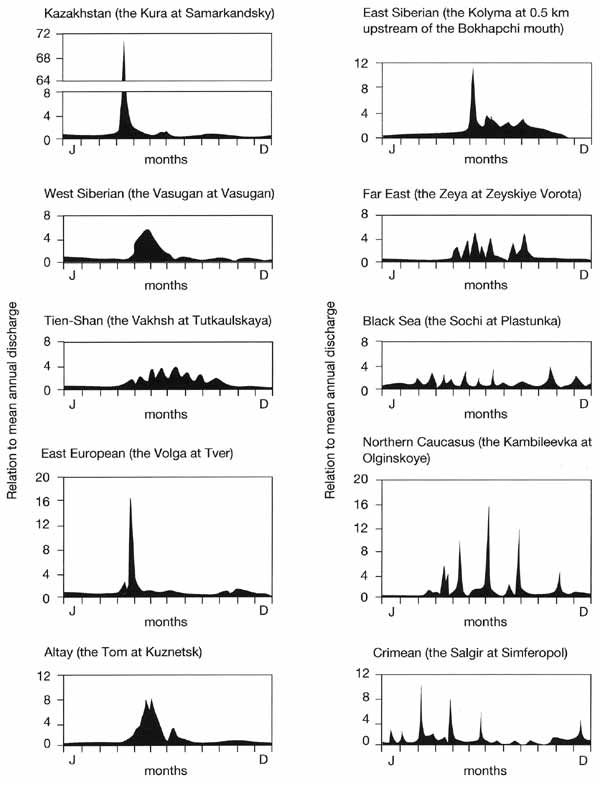Please put an active hyperlink to our site (www.rusnature.info) when you copy the materials from this page
Physical Geography of Northern Eurasia
Rivers, Lakes, Inland Seas, and Wetlands
<<< Elements of Water Balance |
Physical Geography Index | Suspended
Sediment and Mineralization >>>
River Regimes and Variability in Runoff
A wide range of climates which occur over Northern Eurasia predetermines a variety of
river regimes. Following Zaykov (1946) it is possible to distinguish ten major types which
are given in Figure 5.6.

Fig. 5.6 Typical river regimes in Northern Eurasia. Modified from Zaykov
(1946)
Because of the strong climatic seasonality, most rivers of Northern Eurasia are
characterized by a highly uneven annual distribution of runoff. The spring flood regime
prevails across most of the territory. The spring water levels are especially high on the
rivers draining more southern catchments (i.e., in the mixed forest, forest-steppe, and
northern steppe zones). Further north, snow melt is a crucial control (although in the
tundra and taiga, snow melts at a much slower rate) and other factors, such as rainfall
and ground water, are also important. Therefore, the difference between the spring and the
summer water levels is less pronounced. A specific regime develops on the rivers draining
the permafrost areas (the East Siberian type in Figure 5.6). In winter, water gain often
ceases completely, including the seepage of ground water, and the winter levels in such
rivers are extremely low. With air temperatures being often below -40∞C, it is not
unusual for the rivers of north-eastern Asia (including such large rivers as the
Indigirka, Yana, and Anabar) to freeze through to the bottom. In the mountainous regions
summer peaks are typical and on the Pacific coast monsoonal precipitation accounts for the
late summer Ч early autumn peak.
The humid environments of the tundra and the boreal forests are characterized by the
relatively low inter-annual variability in runoff which increases in the arid regions.
While in the forest zone of European Russia the coefficient of variation of mean annual
runoff fluctuates between 0.2 and 0.3, in semi-deserts it exceeds 1.2. The coefficient of
variation is usually low in those regions where lakes and swamps are widespread. Many
studies, based on long-term records and analysis of sediments, have shown that longer-term
fluctuations and periodicities in runoff exist (Shiklomanov and Markova, 1987). For
example, a hundred-year cycle in variability of the Dnieper runoff has been found by
Shvetz (1978) within the 3800-year period on the basis of the analysis of silt deposits in
Lake Saki in the Crimea. However, the greatest attention has always been given to the
runoff fluctuations in the Volga. The low values of water discharge in the 1970s and a
drop of the Caspian level prompted the development of projects concerned with water
diversions from the northern rivers. Higher levels of runoff resumed in 1979 and were
followed by a rise of the Caspian level and flooding of some of the adjacent lowlands (see
below).
<<< Elements of Water Balance |
Physical Geography Index | Suspended
Sediment and Mineralization >>>
|